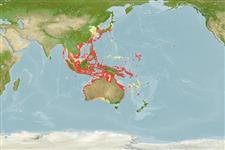Common names from other countries
>
Acanthuriformes (Surgeonfishes) >
Siganidae (Rabbitfishes)
Etymology: Siganus: Latin, siganus = a fish, rabbit fish; by the similarity of the nose (Ref. 45335).
Environment: milieu / climate zone / depth range / distribution range
Ecologia
marinhas; estuarina associadas(os) a recifes; oceanódromo (Ref. 51243); intervalo de profundidade 1 - 50 m (Ref. 9813). Tropical; 42°N - 37°S, 90°E - 171°E
Western Pacific: southern Korea, southern Japan, Ogasawara Islands, Taiwan, southern China, Malaysia, Singapore, Thailand, Andaman Islands, Indonesia, Philippines, Yap, Palau, Pohnpei (Caroline Islands), Solomon Islands, Papua New Guinea, Vanuatu, New Caledonia, and Australia. Often misidentified as Siganus canaliculatus (Ref. 2334).
Comprimento de primeira maturação / Tamanho / Peso / Idade
Maturity: Lm 5.6 range ? - ? cm
Max length : 40.0 cm TL macho/indeterminado; (Ref. 9813); common length : 25.0 cm TL macho/indeterminado; (Ref. 9813)
Espinhos dorsais (total): 13; Raios dorsais (total): 10; Espinhos anais 7; Raios anais : 9; Vértebras: 13. Body olive green or brown above, silvery below; fish frequently with a dark patch below origin of lateral line. Adults become mottled when frightened. Slender, pungent, venomous spines. Preopercular angle 89°-95°. Lower half to 2/3 of cheeks commonly covered with weak, scattered scales. Midline of thorax between pelvic ridges. Differs from S. argenteus in details of coloration and less deeply forked tail (Ref. 37816).
Inhabits algal and seagrass flats and shallow lagoon and coastal reefs (Ref. 9710, 11230). Forms schools. Mainly diurnal. Juveniles feed on filamentous algae, adults feed on leafy algae and seagrasses (Ref. 9710). Commercially cultured in Japan. Commonly found in large estuaries (Ref. 9002). Anterolateral glandular groove with venom gland (Ref. 57406).
In Belau, ripe individuals form prespawning congregations of 30-60 individuals in shoal areas of inner reef flats; spawning occurs on the 4th or 5th day of the new moon; spawning sites are near reef edge. About 300,000 eggs/female at a single spawning. Individuals that spawn in consecutive yrs. & that 2+ yr. class fish could spawn more than once in a single season. Aug (Ref 1754) in Belau.
Woodland, D.J., 1990. Revision of the fish family Siganidae with descriptions of two new species and comments on distribution and biology. Indo-Pac. Fish. (19):136 p. (Ref. 1419)
Status na Lista Vermelha da UICN (Ref. 130435)
CITES (Ref. 128078)
Not Evaluated
Uso pelos humanos
Pescarias: espécies comerciais; Aquacultura: espécies comerciais
Ferramentas
Relatórios especiais
Baixar XML
Fontes da internet
Estimates based on models
Preferred temperature (Ref.
115969): 22.6 - 29, mean 27.9 (based on 760 cells).
Índice de diversidade filogenética (Ref.
82804): PD
50 = 0.5000 [Uniqueness, from 0.5 = low to 2.0 = high].
Bayesian length-weight: a=0.01288 (0.00826 - 0.02009), b=2.99 (2.86 - 3.12), in cm Total Length, based on LWR estimates for this species & Genus-body shape (Ref.
93245).
Nível Trófico (Ref.
69278): 2.0 ±0.1 se; based on diet studies.
Resiliência (Ref.
120179): Elevada, tempo mínimo de duplicação da população menor que 15 meses (Preliminary K or Fecundity.).
Fishing Vulnerability (Ref.
59153): Low vulnerability (21 of 100).
